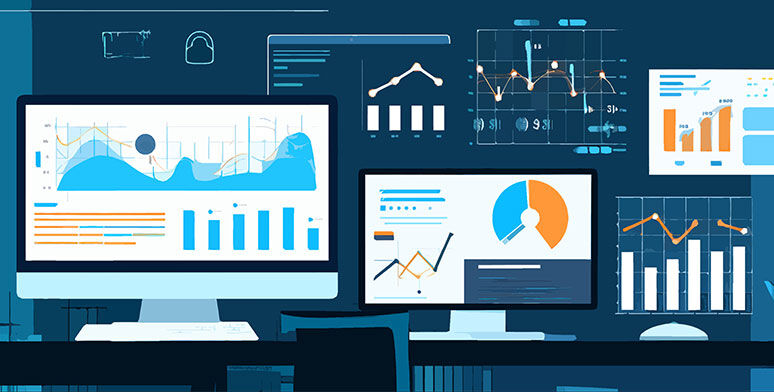Data Analysis and Data Analytics: What’s the Difference?
Now that you have your data, let’s turn to analysis and analytics. The terms "data analysis" and "data analytics" are often used interchangeably, but they have distinct meanings depending on the context. Here’s a breakdown of the core differences between data analysis and data analytics 101.
Data Analysis refers to the process of examining, cleaning, transforming, and modeling data. The basic goal of data analysis is to discover useful information that informs conclusions and supports decision-making.
- Exploratory: Involves exploring data to identify patterns, anomalies, and initial insights.
- Descriptive: Focuses on summarizing historical data to understand what happened.
- Techniques: Includes descriptive statistics, data visualization, and basic statistical analysis.
- Tools: Commonly uses tools like Excel, SQL, and basic visualization software.
- Outcome: Produces reports, dashboards, and summaries that describe the data.
Data Analytics is a broader field that includes different techniques and processes for generating insights from data. It often includes not only data analysis, but also predictive modeling, machine learning, advanced statistical methods, and artificial intelligence, therefore it is a core aspect of any intro to data science. Analytics go beyond basic analysis to include predictive and prescriptive analytics. Current leading tools and programming languages for interpreting data include Python, R, SAS, and more specialized analytics platforms. The goal is to predict future trends, provide recommendations, and automate decision-making processes. Analytics involves multiple stages to generate actionable insights - including data collection, processing, analysis, and interpretation.
In summary, data analysis is a key component and even a starting point for the basics of data analytics. Data analysis is primarily concerned with understanding the past by examining data, while data analytics applies that understanding to predict and influence future outcomes. Learning data analysis and analytics is crucial for having a deeper understanding of all forms of data.
For Beginners: 5 Steps to Learning Data Analysis
Technologies and methods are evolving quickly. For beginners training in data analysis, it can be hard to know where to begin. Being able to work effectively with data is an important skill in the workplace, so get started whenever you are ready by using data analytics! Here are some steps to get started:
- Start with a Goal. What business problem or question do you want to address that would be informed by data? Think about a process that you want to describe or improve, an outcome you want to measure, or something you want to know about your customers. Write down specific goals. Here’s an example: If you are a complaint case manager, your goal might be to understand how many cases are handled by your group at key times of the year.
- Find/Collect the Data. Identify data that answers your question and where that data resides (what system it is in). This may include an existing system or database, log books, surveys, reports, or websites. As a complaint case manager, you might need case names or logs and counts, staff case assignments, and case start and end dates.
- Organize or “Clean” the Data. Preparing data for analysis is often the most time-consuming step, especially when you are gathering data for analysis for the first time. The initial product can be the starting point for defining a new database or system, particularly if you want to repeat the analysis or gather data in a new way. You may need to fill in missing data, change the formatting for consistency, or combine different data sources into one place. Much of this work will be driven by what systems or data records already exist.
- Explore and Analyze the Data. Exploratory data analysis (EDA) simply means playing with the data to understand its main characteristics. You might determine counts, and develop descriptive statistics (such as the average, minimum and maximum, standard deviation) and how these descriptive statistics change in different time periods. This summarizes the data and allows you to start comparing different aspects, like values for certain people or at different times. Here’s an example: Create a histogram to see the distribution of cases over time and a bar chart to compare total case counts or average completion time across different case workers. Once you have mastered this basic analysis, advance to more complex techniques, like correlations or regression analyses.
- Interpret and Communicate Your Results. Show what you know! Summarize the main findings of your analysis in text or bullet points. Use visual aids like charts, graphs, and tables to make the data easily understandable. Explain what the findings mean in the context of your original goal, and what they suggest in terms of future possible actions or decision-making.
Here are some basic technology tools for beginners learning data analysis:
- Microsoft Excel: Good for basic data manipulation and visualization.
- Google Sheets: Similar to Excel, with cloud collaboration features.
- SQL: For querying databases to retrieve and manipulate data.
- Tableau or Power BI: More powerful tools for creating interactive data visualizations (your organization may have a subscription to a tool).
For greatest success, start small when learning data analysis to gain confidence and skills – pick a simple question that you have data readily available, and Go! After that, seek new questions and new data - consistent practice helps reinforce your learning. You may also want to practice your networking, by engaging with online forums, training, or professional networks.
Workplace Training on Data and Analytics
This introduction to data analytics might end here, but Pryor Learning offers several courses and resources related to data that are suitable for employees of all positions.
Our Using Business Analytics to Become a Goal-Oriented Manager is a half-day seminar that helps you grow your data literacy and transform facts and figures into actionable metrics.












